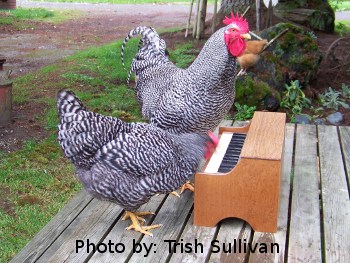 History
History
Barred rocks were developed in New England in the 1800s. The Barred Rock entered the standard in 1874.
The exact heritage of the Barred Rock is slightly unclear, as several people have claimed credit for developing the breed. Barred Rocks appear to have been developed from crosses between Dominiques, Black Javas, Cochins and possibly several other breeds.
Sometimes they are referred to by the name “Plymouth Rock,” a term that more accurately refers to the entire breed, which also includes other color varieties, such as White Rocks or Buff Rocks. Using the name “Barred Rock” helps to avoid this confusion.
Qualities
- Cold Hardy — the Barred Rock tolerates cold weather very well but also does well in warm climates.
- Prolific Brown Egg Layer — Barred Rocks are excellent layers of large, brown eggs.
- Dual Purpose — Both males and females grow to be a good sized bird with a plump carcass and yellow skin, making them a fine bird for roasting. They are an excellent farm or backyard chicken to raise for both meat and eggs.
- Size — Males can reach 9.5 pounds at maturity and females 7.5 pounds.
Physical Appearance
- Comb — They have a single comb.
- Eye Color — Reddish bay.
Baby chicks are dark gray to black with some white patches on their head and body.
As mentioned earlier, Barred Rocks are one color pattern within the breed known as “Plymouth Rocks.” Some other Plymouth Rock color patterns include: White Rocks, Buff Rocks, Partridge Rocks and Silver-Penciled Rocks.
Videos of Barred Rock Chicks
Availablity on Our Website
To check the availability on our website, visit the links below:
- Barred Rock Day Old Baby Chicks — males, females and straight runs
- Barred Rock Started Pullets — females only
- 4-9 Week Old Barred Rocks — females only



Everyone told me Orpington’s were people chickens. I have a barred rock, one out 40 chicks (6 weeks) that greets me at the gate, lets me pick her up, follows me around, and she coos when she is near me, that is if a chicken coos. I guess what I am saying is they seem to be people friendly also.